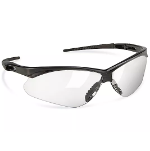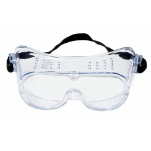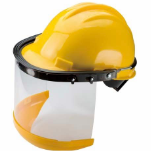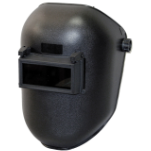Subsection 1.3.2 Eye Protection
Every day more than 1,000 eye injuries occur in American workplaces. The US Bureau of Labor Statistics found that three out of five workers who suffered eye injuries were not wearing eye protective equipment at the time of the accident, and when asked why, the victims often claimed that eye protection was not normally used in their type of work, or it was not required for the type of work performed at the time of the accident. Eye protection can save your sight, but you must be wearing it.
Eye injuries can occur in many ways, but are primarily caused by rapidly flying objects. The BLS found that almost 70% of eye injuries were caused by flying or falling objects or sparks striking the eye. Most of these objects were smaller than a pin head, and were traveling faster than a hand-thrown object. Another 20% of eye injuries were caused by chemicals, and the remainder due to miscellaneous causes such as objects swinging into the eye, pulled into the eye or by light radiation.
Eye injuries can be prevented by wearing effective eye protection. To be effective, the eyewear must be of the appropriate type for the hazard encountered and properly fitted. The BLS survey found that 94% of the injuries to workers wearing eye protection were caused by objects or chemicals going around or under the protector. Goggles provide better protection than face shields or safety glasses, but the best protection is afforded when both goggles and a face shield are worn together.
The three main types of eye protection for general maintenance are safety glasses, goggles, and face shields. In addition, when welding, specialized equipment must be used to protect your eyes. Each method of eye protection has its own advantages and disadvantages.




Safety glasses are lightweight glasses that have shatter resistant lenses made of materials like polycarbonate or propionate plastic and often have side shields attached to the side pieces. Safety glasses are designed to stop flying objects such as chips, fragments, sand, and dirt from injuring your eyes. They also can provide laser light filtration to prevent reflections from the laser entering the eye and causing retinal burns. Safety glasses can be purchased with prescription lenses including bifocals if necessary.
The main advantage of safety glasses is that they are lightweight and relatively comfortable to wear for long periods of time. The provide little to no protection from liquids or vapors, and some flying particles may get around the side shields.
Safety goggles provide more complete protection of the eye than safety glasses, since they protect against both frontal and side impact. They come in two different types, vented and non-vented. Vented goggles are used to protect your eyes from splashes and flying objects, while Non-vented Goggles additionally protect your eyes from hazardous vapors, mists, and fumes.
Face shields are designed to augment other types of eye protection and are not meant to be a stand alone form of eye protection. Face shields are used to protect your entire face with goggles on under the shield to catch any liquids that might make it past the shield.
Welding helmets are specialized helmets are used by welders to protect their eyes and face from the intense light, sparks, and heat generated during welding processes. They often feature auto-darkening lenses that adjust the shading based on the brightness of the welding arc.
Always wear a welding helmet when arc welding. Your eyes, face, and neck need protection against the burning rays of the arc, and from the splatter of molten metal and slag. To protect your eyesight, make sure the welding helmet has a colored lens with at least a No. 10 shade when welding with 200 amperes or less. And never strike a welding arc before your helmet is in place. Never look at an arc from any distance with your naked eyes while someone else is welding.
Never chip slag when your eyes (or those of others nearby) are not protected by goggles, an eye shield, or the clear lens of a welding helmet. If fragments of hot slag were to hit the eye, medical attention would be required for their removal, and blindness could result. The risk of permanent eye injury is so great that you should never chip slag from a weld without protecting your eyes.

